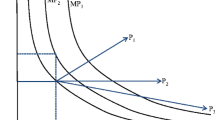Abstract
Because technology plays such an important part in our daily lives, in our businesses, and in government policy, we need to understand it better. But technology has not undergone the elegant simplification that marks the development of most fields of knowledge as they grow to maturity. To achieve simplification we need first to discover the fundamental structure that underpins all technologies. Such a structure may well turn out to be one of the more significant conceptual foundations of the new century. What is the state of knowledge in this area? Beginning with Babbage early in the nineteenth century, many attempts have been made to create such a structure. The history of these attempts is poorly recorded with no well-documented central theme. One approach, called Strategic Technology Analysis (STA), seems to have advanced a little further than most others. It focuses on the intrinsic characteristics of technologies. Based on these characteristics, the field offers a set of frameworks for analyzing individual technological entities as well as entire technological landscapes. These frameworks cover the (1) anatomy, (2) taxonomy, (3) evolution, and (4) ecology of technology. This article traces the development of these frameworks. It recommends that they be scrutinized anew and evaluated as part of a revitalized search for fundamental structure.
Similar content being viewed by others
References
Abernathy, W.J. and Wayne, K. “Limits to the learning curve” in Tushman, M.L. and Moore, W.L. 1984. Readings in the Management of Innovation, London, Pitman, pp. 109–121 (reprinted from the Harvard Business Review, September/October 1974.)
Amber, G.H. and Amber, P.S. 1962. Anatomy of Automation, Englewood Cliffs, N.J. Prentice Hall.
Ashby, M.F. 1987. “Technology in the 1990s: Advanced materials and predictive design. Proceedings of the Royal Society, Discussion Meeting, 4–5 June 1986, London, The Royal Society.
Ayres, Robert U. 1988. “Barriers and breakthroughs: An ‘expanding frontiers’ model of the technology-industry life cycle,” Technovation, Vol. 7, Issue 2, May, pp. 87–115.
Ayres, Robert U. 1968. “Envelope curve forecasting,” in Bright, James R (ed): Technological Forecasting for Industry and Government, Englewood Cliffs, New Jersey (Prentice Hall), pp. 77–94.
Badawy, M.K. 1996. “A new paradigm for understanding management technology: A research agenda for ‘technocologists’,” International Journal of Technology Management, Vol. 12, No. 5/6, Special Issue, pp. 717–732.
Bright, J. R. 1963. “Opportunity and threat in technological change,” Harvard Business Review, Vol. 41, No. 6, November/December pp. 76–86.
De Gregori, Thomas R. 1985. A Theory of Technology, Ames, Iowa (The Iowa State University Press).
De Meyer, 1988. “The way forward in the strategic management of technology,” R&D Management, Vol. 18, No. 2, pp. 107–109.
De Vulpian, A. 1984. New Directions for Innovations in Products and Services, Congress d’Esomar, Rome and Paris, COFREMCA., p. 32.
Dosi, Giovanni. 1982. “Technological paradigms and technological trajectories,” Research Policy, Vol. 11, pp. 147–162.
Farrell, C.J. 1993. “A theory of technological progress,” Technological Forecasting and Social Change, Vol. 44, pp. 161–178.
Fisher, J.C. and Pry, R.H. 1971. “A simple substitution model of technological change,” Technological Forecasting and Social Change, Vol. 3, pp. 75–88.
Foster, Richard. 1986. Innovation: The Attackers Advantage, New York (Summit Books).
Gaynor, G. 1996. Handbook of Technology Management, McGraw Hill, New York, pp. 5.9–5.24.
Grupp, H. and Hohmeyer O., 1986. “A technometric model for the assessment of technological standards and their application to selected technology intensive products,” Technological Forecasting and Social Change, Vol. 30, pp. 123–137.
Horner, D.S. 1992. “Frameworks for technology analysis and classification,” Journal of Information Science, Vol. 12, No. 1, pp. 57–68.
Khalil, T.M. 2000 Management of Technology: The Drivers of Technological Changes in the Twenty First Century, University of Miami.
Le Duff, R. and Maïsseu, A. 1988. L’Anti-declin, ou les mutations technologiques maitrisées, Paris, E.S.F.
Linstone, H.A. and Sahal, D. 1976. Technological substitution, Elsevier, New York.
Majer, H. 1985. “Technology measurement: The functional approach,” Technological Forecasting and Social Change, Vol. 27, pp. 335–351.
Mansfield, E. 1961. “Technical change and the rate of imitation,” Economica, Vol. 29, No. 4, pp. 741–766.
Mazlish, B. 1993. The Fourth Discontinuity, Vail Ballou Press, Binghamton, New York.
Rapp, F. 1974. Contributions to the Philosophy of Technology, Dordrecht, Holland, D. Reidel Publishing Company.
Rodick, A. 1990. “Macmillan educational lecture” Conference of the Geographical Association. Referred to in Ledgerwood, G, Street, E, and Therivel, R., 1994, The Environmental Audit and Business Strategy, Pitman Publishing, London, p. vii.
Ropohl, Gunter. 1979. Eine Systhemteorie der Technik, Munich and Vienna Carl Hanser Verlag.
Sahal, D. 1985. “Foundations of technometrics,” Technological Forecasting and Social Change, Vol. 27, pp 1–38.
Shurig, R. 1984. “Morphology: A tool for exploring new technology,” Long Range Planning, Vol. 17, No. 3, pp. 129–140.
Simmonds, W.H.C. 1991. “Is sustainability the key to professionalism in futures?” Futures Research Quarterly, Vol. 7, No. 1, Spring, pp. 85–95.
Steyn, H. de V. and de Wet, G. 1994. “Technological limits and the hierarchies of product systems,” Technological Forecasting and Social Change, Vol. 46, No. 1, pp. 11–15.
Teichmann, D. 1974. “On the classification of the technological sciences” in Rapp, F. (ed) Contributions to a Philosophy of Technology, Dordrecht, Holland, D. Reidel Publishing Company, pp. 134–139.
Van Wyk, R.J. 1979. “Technological forecasting: A macro-perspective.” Technological Forecasting and Social Change, Vol. 15, pp. 281–296.
Van Wyk, R.J. 1988. “Management of technology: New frameworks.” Technovation, Vol. 7, pp. 341–351.
Van Wyk, R.J. 2000. “A macro map of medical technologies: Introductory thoughts.” International Journal of Health Care Technology and Management, Vol. 2, Nos. 1/2/3/4, pp. 206–217.
Author information
Authors and Affiliations
Additional information
He provides professional support to technology executives, conducts executive programs and teaches academic courses on the MS-MOT degree. His research interests concern the fundamental structure of technology and the development of a universal code for technology.
Rights and permissions
About this article
Cite this article
van Wyk, R.J. Technology: A fundamental structure?. Know Techn Pol 15, 14–35 (2002). https://doi.org/10.1007/s12130-002-1002-4
Issue Date:
DOI: https://doi.org/10.1007/s12130-002-1002-4




